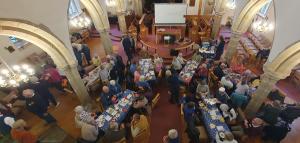Vaccination ancient and present by Sean Livsey
Thu, Oct 12th 2023 at 7:00 pm - 9:00 pm
putting into perspective vaccination processes
Club members please log in for more information.
12th October 2023 Vaccination: past, present and future – Shaun Livsey
Shaun explained that he was a retired biomedical scientist, having spent most of his time at Leicester Royal Infirmary, but also having done some VSO work in West Africa and the Ebola epidemic in Sierra Leone. A bacteriologist rather than an immunologist and he would try to cover
- The importance to human society
- Early development
- How it works
- Future developments
Historically, what we died of 100 years ago:
1910: pneumonia, influenza, tuberculosis, gastrointestinal infections, infection related heart disease, diphtheria etc resulted in 55% of the population dying of infection-related disease.
Whereas in modern times (2010) we suffer from influenza and cancer, but <4% die from such infectious diseases. Although antibiotics and improved living conditions have played a role, this major reduction is down to mass vaccination.
The 1st vaccination was against smallpox in China in 900 AD, but it was called ‘variolation’ (after the variola virus); scrape the pustules and give the patient the small pox by blowing up their nose, which produces a mild form with 2 to 3% chance of dying compared with 20 to 80% without.
British variolation began in 1742 when the Constantinople’s ambassador’s wife, Lady Mary Montagu copied the process and they returned to Britain and trials were organised in Newgate prison. Edward Jenner in 1796 picked up on the complexion of milkmaids to use cowpox to prevent smallpox, inoculating his 9 yo gardeners’ son and months later exposing him to smallpox several times without problems, so published in 1801 and gradually vaccination took off, saving millions. 300 million deaths from small pox between 1900and 1980; 20%-60% adult fatality and up to 80% in children. Epidemics with high fever, fatigue, rash-extensive spots full of pus with survivors suffering scaring and possible blindness. The last natural case was in 1977 (Somalia)with the last outbreak in Birmingham in 1978, with Global eradication by 1980
Vaccine No 2 was cholera, in 1870 when a serendipitous accident by Louis Pasteur’s research assistant using a 4-week-old culture, developing the concept of a ‘weakened pathogen’, but only used on chickens.
Vaccine No 2 ctd. Anthrax-Bacillus anthracis- vaccine for cows and humans 1881.
Vaccine No 3 Rabies (Pasteur again) he infected rabbits to grow the virus and mixed their spinal cord with formaldehyde to create the vaccine.
Diphtheria anti-toxin 1894; Spanish Flu (no vaccine) 1918 to 1920, 20 to 50 million killed, 1st vaccine in 1942 (Salk et al); BCG -Tuberculosis vaccination (Bacillus Calmette, Guerin) 1st used 1921.
Shaun talked about the bugs antigen shapes and use of anti-bodies, white blood cells having memories and the 6 types of vaccines: live attenuated, inactivated, toxoid, sub-unit, recombinant and mRNA and the effect they have had on average life expectancy: in 1841 40 years whilst in 2020 it’s 80 years.
He touched on why some people are against vaccination and some of the modern diseases: Cancer; autoimmune; diabetes and Alzheimer’s.
Shaun fielded questions on polio and Covid and Clive provided the Vote of thanks saying what a fascinating talk delivered with injections of humour and a very interesting subject which the members agreed with their normal round of applause. AR
'What We Do' Main Pages:

We have now successfully run this event for 10 years. Full reports of each year are available under this main page
more
It's here that you can read what we've been up to in the last few months. For more information on our work in the local community, with our young people and internationally please access "what we do" section of this web site.
more
This is a monthly meeting open to visitors from Bingham, Radcliffe, Cotgrave and all villages in surrounding area.
moreThis committee are involved in planning now we can raise funds for our chosen charities
moreIf you like what we do as an organisation and are interested in volunteering with us, keeping up to date with our plans and future events then why not consider signing up as a friend of our Rotary Club
moreOur International Committee is involved with Polio Plus - a Rotary initiative to eradicate Polio, World-wide; Sand dams; Aqua Boxes; Shelter Boxes; Collecting used spectacles, and many other projects
moreHere you can read about the many meetings we've had during our formation as a Rotary Club. The early years are a little short on detail...
more



